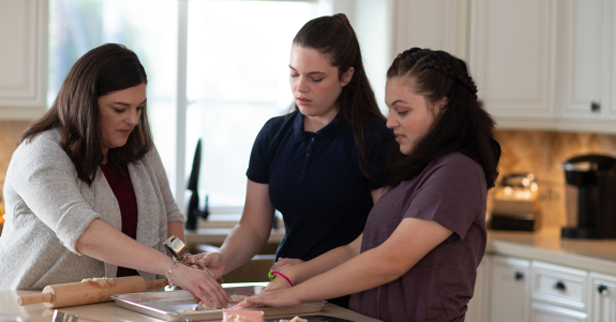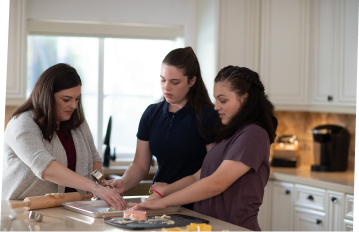Supporting Siblings
The impact of Dravet syndrome can be especially hard for brothers and sisters of diagnosed children. To help make sure that they're also understood and supported, we've provided some resources especially for siblings.
Keeping siblings in the loop
When parents of those with Dravet syndrome keep their other children up to date, they help them better understand and
cope. Having knowledge about their sibling’s condition can have positive effects on their mental health.
 Understanding Dravet syndrome can help lower depression and anxiety
Understanding Dravet syndrome can help lower depression and anxiety
Up to 76% of siblings who understood the basics of epilepsy or who had helped during a seizure
reported being in better moods.
 Knowledge of their sibling's condition can bring comfort
Knowledge of their sibling's condition can bring comfort
Up to 86% of those who were informed about the status of their sibling's condition reported feeling
more comfortable talking about it with other people.


Christian is almost two years old and we’ve been talking to him about Giovanni's diagnosis. He repeats now, ‘Giovanni is having a seizure.’ Sometimes he lays his hand on Giovanni, and we tell him to let his brother know, ‘Giovanni, I'm here. Giovanni, you're okay.’ I don't know that he fully understands, but he knows that something is happening and that we all respond.
—Danitza, mom of Giovanni, age 4
Communicating with siblings about Dravet syndrome
 Plan the conversation
Plan the conversation
Think about when and where your child will feel the most comfortable. Then come up with a plan for how you’re going to say what you need to say. Having something written out in advance will help you feel more prepared. Here are some conversation starters:
- “How do you feel about your brother or sister right now?”
- “How do you feel about everything that happened today?”
- “It’s OK for you to feel this way. Let me tell you a story about a time I felt the same way.”
 Ask how you can improve
Ask how you can improve
Try asking your child what you can do better. Openly talking about how you’re doing in relation to their individual needs can help you make sure you’re giving them the attention they deserve.
 Express your gratitude
Express your gratitude
Letting your child know how much you appreciate their help can be meaningful, because it may make them feel recognized and valued. Giving your child something that feels more official, like a thank you letter or badge of honor, could go a long way, too.
 Talk to a therapist
Talk to a therapist
Sometimes children have a difficult time discussing their feelings with their parents. By seeking out a school counselor or a therapist, your child has the opportunity to express his or her feelings to a neutral party with no connection to the family. Therapy can also help them cope, communicate, and handle situations better. Many therapists will start play therapy with children as early as 3 or 4 years old.
 Meet them eye to eye
Meet them eye to eye
Positioning yourself at the same eye level as your child during your conversation may help them feel more comfortable opening up.
 Keep it positive
Keep it positive
Try keeping your conversation as easy to understand and positive as possible. Encourage your child to ask questions and be honest about their concerns or fears. Try not to criticize them if they say something mean. Explain why it is important to think of others’ feelings. If they get down on themselves, remind them of the positive traits they have as a result of being the sibling of someone with Dravet syndrome, such as willingness to help those in need.
 Create a plan together
Create a plan together
When your child with Dravet syndrome has a seizure, it’s important to know what exactly makes their siblings most comfortable. Some might want to be involved, while others might prefer to distract themselves in another room. If they want to help, consider giving them an age-appropriate task that they can do, like grabbing a blanket or writing down the time the seizure started. Talking about this together and creating a plan in advance can help them feel better prepared.
Download the Seizure Planning Tool

Dedicating time to siblings
It’s important to set aside individual time for siblings without Dravet syndrome to help them feel supported and maintain your relationship. Parents and caregivers who we spoke to suggested:
- Do something simple, such as going for a walk, or out for ice cream
- Create a yearly tradition, such as an overnight trip to a nearby city
- Allow them to stay up late one night for a game, like hide-and-seek
- Set aside a small chunk of time, such as bedtime, to talk about your day
- After a difficult day, give them a special treat to show your appreciation


Even if it's just a little chitchat before [Hannah] goes to sleep, I try to be there for her in the little moments.
—Erin, mom of Mia, age 16
Resource kits for siblings and parents
These kits made by the Dravet Syndrome Foundation (DSF) and UCB remind siblings how important they are, and give parents resources to help manage the impact of Dravet syndrome on their family.
Get sibling resource kits
Get support and inspiration from other parents and caregivers from Shine Forward With Dravet
Sign up now